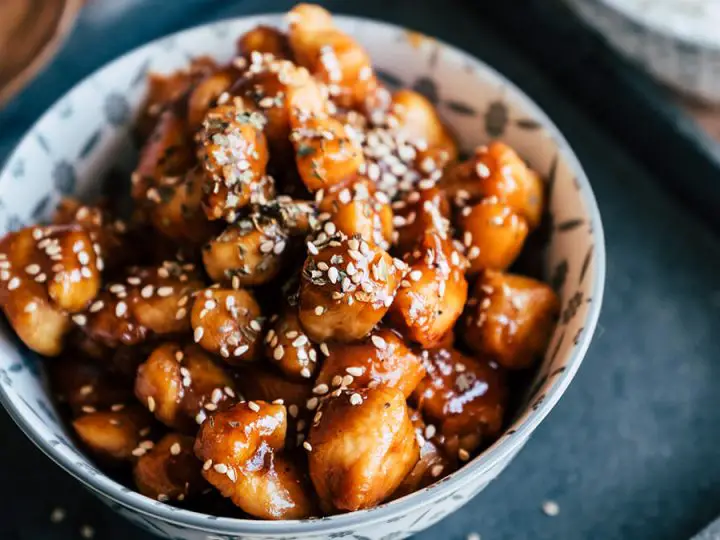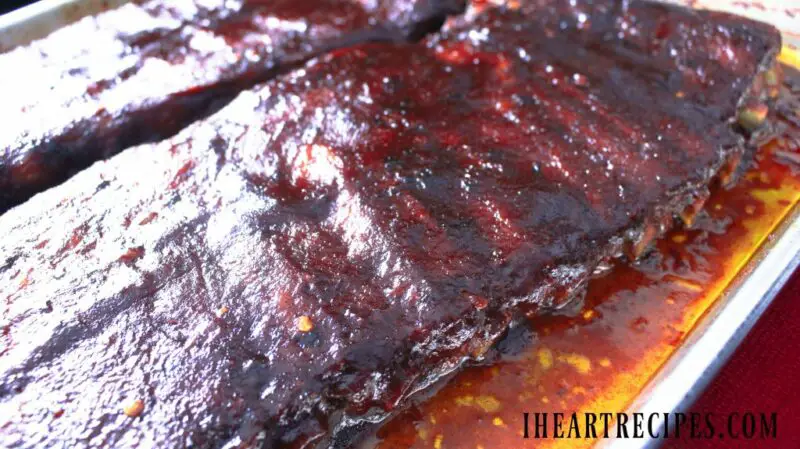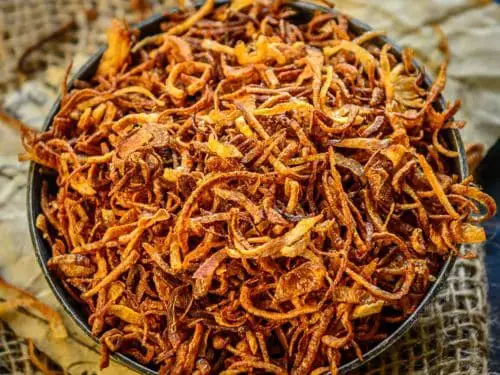Cooked samosas are a delicious treat that many of us enjoy. But what happens if you have leftovers? How long do cooked samosas keep in the fridge? In this article, we will explore the optimal storage of cooked samosas and the best ways to reheat them, ensuring that you can enjoy their flavors even after they have been cooked.
Key Takeaways:
- Cooked samosas can be stored in the fridge for up to 5-7 days.
- To ensure optimal storage, wrap them tightly in foil and transfer them to an airtight container.
- Smell the samosas before reheating and discard them if they have a moldy or weird smell.
- The oven method is the recommended way to reheat samosas as it maintains their crispy texture.
- Alternative methods include stovetop reheating, microwave, deep-frying, and barbecuing.
- When freezing samosas, use an airtight container or tightly wrap them in foil or cling film.
- Defrost frozen samosas in the fridge before reheating.
The Best Way to Reheat Samosas: Oven Method
When it comes to reheating samosas, the oven method is the way to go if you want to maintain their crispy texture. The oven provides even heating, ensuring that your samosas are heated through without becoming soggy. Here’s how to do it:
- Preheat your oven to 350°F.
- Line a baking pan with parchment paper to prevent the samosas from sticking.
- Place the samosas on the baking pan, making sure to leave some space between each one.
- Heat the samosas in the oven for 5-10 minutes. You may need to flip them once or twice to ensure that both sides are heated evenly.
- Check the filling temperature to ensure it is heated through. You can use a food thermometer to make sure it reaches a safe temperature.
- Allow the samosas to cool for a few minutes before serving. This will help them retain their crispy texture.
By using the oven method, you can enjoy reheated samosas that are just as delicious and crispy as when they were freshly cooked. It’s an easy and convenient way to enjoy this popular snack without compromising on taste or texture.
Table: Oven Method for Reheating Samosas
| Step | Instructions |
|---|---|
| 1 | Preheat oven to 350°F. |
| 2 | Line baking pan with parchment paper. |
| 3 | Place samosas on baking pan. |
| 4 | Heat in oven for 5-10 minutes, flipping once or twice. |
| 5 | Check filling temperature for doneness. |
| 6 | Allow samosas to cool before serving. |
The oven method is a reliable and straightforward way to reheat samosas and enjoy them with their signature crispy texture. It’s perfect for gatherings or when you want to savor the flavors of freshly cooked samosas, even after they have been refrigerated. Give it a try and elevate your samosa experience!
Alternative Method: Stovetop Reheating
While reheating samosas in the oven is the recommended method for maintaining their crispy texture, an alternative option is to use the stovetop. This method can be especially convenient if you don’t have access to an oven or prefer a different cooking technique. To reheat samosas on the stovetop, follow these simple steps:
- Heat a non-stick pan over low to medium heat.
- Place the samosas in the pan, ensuring they are not overcrowded.
- Cover the pan with a lid or foil to retain heat and moisture.
- Cook the samosas for a few minutes, then turn them over to ensure even heating.
- Continue cooking and turning the samosas until they are fully heated and crispy.
- Remove the samosas from the heat and allow them to cool for a couple of minutes before serving.
This stovetop method provides an alternative way to reheat samosas while still achieving a delicious result. It is important to use a non-stick pan to prevent the samosas from sticking and to ensure even heating. With this method, you can enjoy warm and flavorful samosas without the need for an oven.
Other Reheating Methods: Microwave, Deep-frying, and Barbecuing
While the oven and stovetop methods are the preferred ways to reheat samosas, there are a few alternative methods you can try if you’re short on time or prefer a different taste and texture. These methods include using a microwave, deep-frying, and even barbecuing your samosas.
Microwave Method
Reheating samosas in the microwave is a quick and convenient option, but keep in mind that the texture may be softer compared to other methods. To microwave samosas, place them on a microwave-safe plate and heat them in short intervals of 30 seconds, checking their temperature and flipping them over each time. Be sure to cover them with a microwave-safe lid or paper towel to prevent splattering.
Deep-frying Method
If you prefer your samosas to be crispy and golden, deep-frying is a great option. However, it’s important to exercise caution to avoid burning or overheating the filling. Heat oil in a deep pan or pot to medium-high heat and carefully place the samosas in the oil. Fry them until they turn golden brown and crispy, about 2-3 minutes per side. Use a slotted spoon to remove them from the oil and place them on a paper towel-lined plate to drain excess oil.
Barbecuing Method
If you’re in the mood for a smoky twist, you can also reheat your samosas on the barbecue grill. Preheat your grill to medium heat and place the samosas directly on the grates. Grill them for about 3-4 minutes per side, or until they are heated through and have grill marks. This method adds a unique smoky flavor to the samosas and can be done while preparing other grilled dishes.
Remember, these alternative methods may vary in terms of taste and texture compared to the oven and stovetop methods. It’s important to consider your personal preference and the time you have available when deciding which reheating method to use for your samosas.
| Reheating Method | Advantages | Disadvantages |
|---|---|---|
| Oven | Maintains crispy texture | Longer reheating time |
| Stovetop | Quick and easy | May result in slightly softer texture |
| Microwave | Convenient and quick | Softer texture |
| Deep-frying | Crunchy and golden exterior | Potential for oil splatter and overheating filling |
| Barbecuing | Smoky flavor | Requires access to a barbecue grill |
Freezing and Storage Tips for Samosas
When it comes to samosas, freezing them can be a convenient way to ensure you always have a delicious snack or appetizer on hand. Whether you have homemade samosas or store-bought ones, proper freezing and storage techniques can help extend their shelf life and prevent food waste. Here are some tips to help you freeze and store your samosas:
- Cooling and wrapping: Allow the samosas to cool completely before freezing them. This helps prevent condensation and ice crystals from forming, which can affect the texture. Once cooled, wrap each samosa tightly in foil or cling film to protect them from freezer burn.
- Airtight containers: Another option is to store the samosas in airtight containers. Make sure the containers are freezer-safe and seal them tightly to prevent air from entering. This helps maintain the quality and flavor of the samosas.
- Labelling: To keep track of the freezing dates and contents, it’s a good practice to label the packages. Include the date of freezing and a brief description of the filling. This makes it easier to identify and sort the samosas when you’re ready to thaw and reheat them.
Now that you know how to freeze and store samosas, it’s worth noting that cooked samosas can be frozen for up to 6 months. When you’re ready to enjoy them, defrost them in the refrigerator overnight. Once thawed, you can follow the reheating methods mentioned in the previous sections.
Table: Freezing and Storage Tips for Samosas
| Step | Tips |
|---|---|
| 1 | Cool the samosas completely before freezing to prevent condensation and ice crystals. |
| 2 | Wrap each samosa tightly in foil or cling film for added protection against freezer burn. |
| 3 | Store the wrapped samosas in airtight containers to maintain their quality and flavor. |
| 4 | Label the packages with the freezing date and a brief description of the filling. |
| 5 | Freeze cooked samosas for up to 6 months. |
| 6 | Defrost them in the refrigerator before reheating. |
By following these freezing and storage tips, you can enjoy samosas at your convenience without worrying about them going to waste. Whether you freeze homemade samosas for future gatherings or stock up on your favorite store-bought variety, proper freezing and storage techniques can help preserve their taste and texture.
Additional Information about Samosas
Let’s delve deeper into the world of samosas! These delectable pastries are a culinary delight that originated in Central Asia and the Middle East. Over time, they have gained popularity and spread to various regions across the globe. Now, let’s explore some fascinating details about these savory treats.
Samosas are typically filled with a variety of ingredients, including potatoes, vegetables, or meat. The filling is carefully prepared and seasoned to create a burst of flavors with each bite. One of the key factors in achieving the perfect samosa is the dough. It plays a crucial role in ensuring a crispy and flaky texture that is simply irresistible.
When it comes to serving samosas, it’s important to consider presentation. To avoid sogginess, it’s best to avoid placing them directly on a plate. Instead, you can use a wire rack or place them on absorbent paper to maintain their crispy exterior. This simple step will enhance the overall enjoyment of this culinary delight.
As you indulge in samosas, take a moment to appreciate the cultural origins behind this beloved snack. From their humble beginnings in Central Asia and the Middle East, samosas have traveled far and wide, captivating taste buds around the world. So, the next time you savor a samosa, remember the rich heritage and intricate craftsmanship that goes into creating this delicious treat.
FAQ
How long can cooked samosas be stored in the fridge?
Cooked samosas can be stored in the fridge for up to 5-7 days.
What is the best way to reheat samosas?
The recommended way to reheat samosas is using the oven method.
How do I reheat samosas in the oven?
Preheat the oven to 350°F, place the samosas on a baking pan lined with parchment paper, and heat them for 5-10 minutes.
Can samosas be reheated on the stovetop?
Yes, samosas can be reheated on the stovetop using a non-stick pan.
How do I reheat samosas on the stovetop?
Heat the pan, place the samosas in it, cover with a lid or foil, and cook on low to medium heat until fully heated.
Can samosas be reheated in the microwave?
While not recommended for optimal results, samosas can be reheated in the microwave for a softer texture.
Can samosas be reheated by deep-frying?
Yes, deep-frying is an option for those who prefer crispy samosas, but caution is needed to avoid burning or overheating the filling.
Can samosas be reheated on the barbecue?
Yes, samosas can be heated on the barbecue, which adds a smoky flavor. They can be heated while preparing other grilled dishes.
Can samosas be frozen?
Yes, both homemade and store-bought samosas can be frozen.
How long can cooked samosas be frozen?
Cooked samosas can be frozen for up to 6 months.
How should samosas be defrosted?
When defrosting, samosas should be thawed in the fridge before reheating.
What are samosas?
Samosas are pastries filled with savory ingredients and are traditionally deep-fried. They originated in Central Asia and the Middle East.
What fillings are used in samosas?
Samosas can be filled with various fillings like potatoes, vegetables, or meat.
How can sogginess be prevented when serving samosas?
Avoid placing samosas directly on a plate to prevent sogginess.




